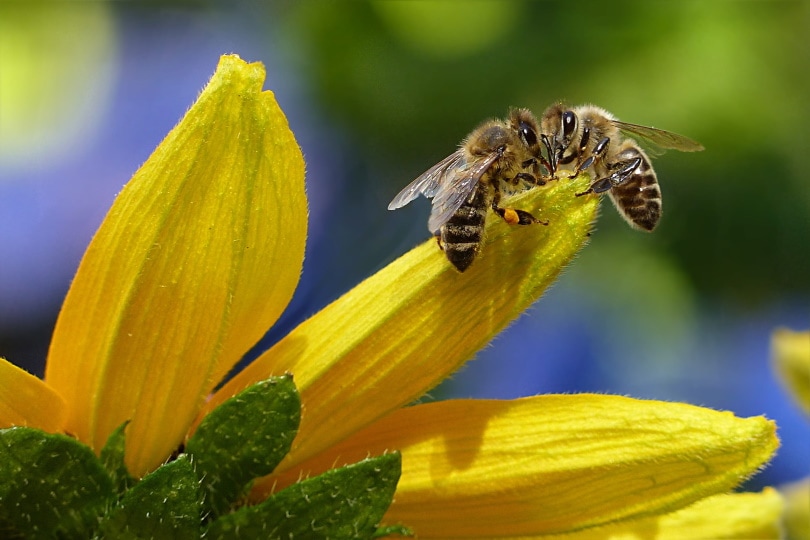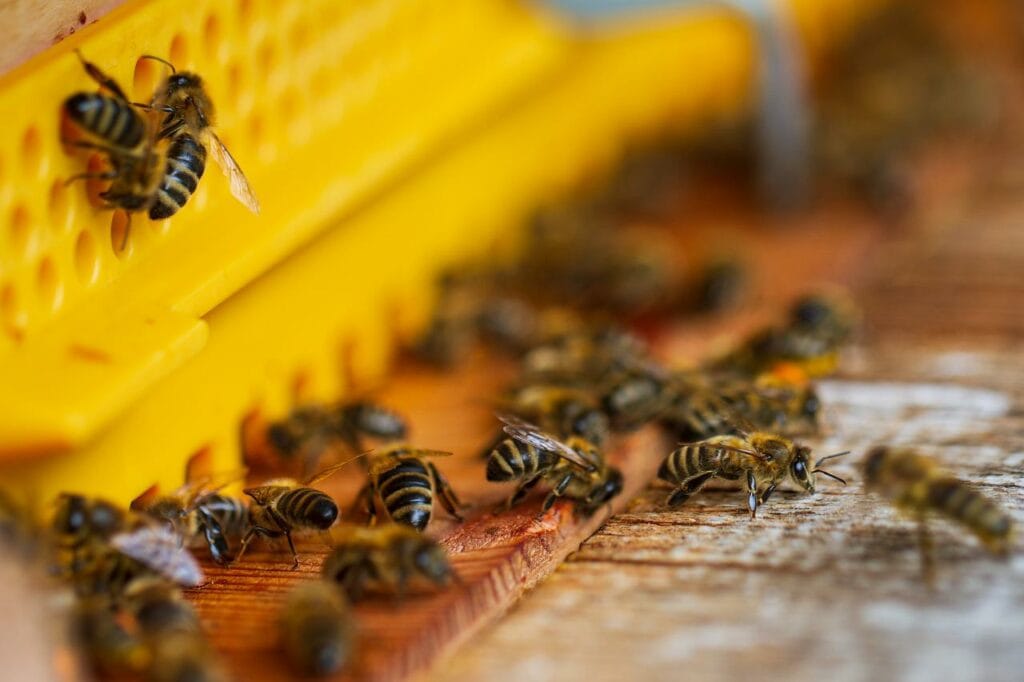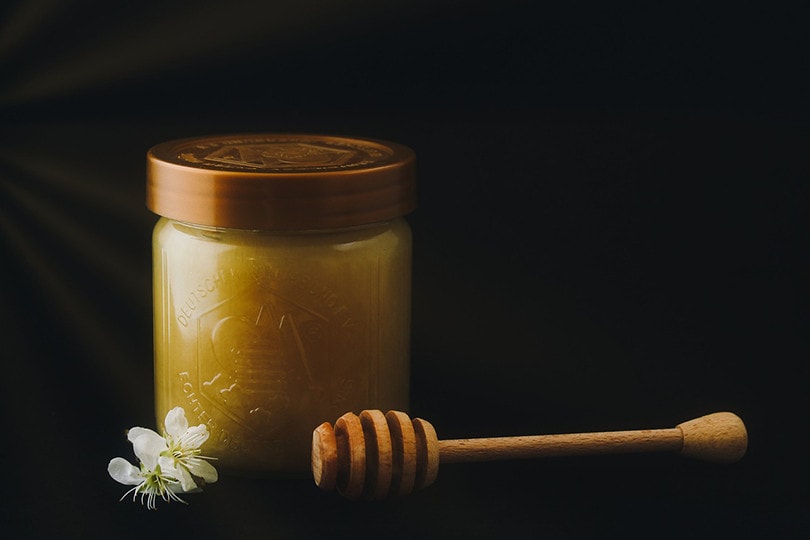How Do Bees Make Honey? Types, Facts, & FAQ
-
Pete Ortiz
- Last updated:

Honey is a natural, healthy sweetener loved and used by millions worldwide. Bees are incredible beings that live and work in an organized society. Most people know they make honey by collecting pollen from flowers, but just how does this fascinating process work? Honey is made slowly and diligently by the tiny workers that collect nectar from various flowers. Bees have a very short life span, but they spend their lives primarily caring for the colony and queen.
If you’ve wondered how bees make honey, you can find all the answers in the article below, as we dwell a bit on how and why these creatures devote their short lives to making honey.
Collecting and Storing Nectar

The fascinating process of making honey begins with the worker bee foraging in the wild. Bees look out for ideal flowers to drink the nectar from. The flowers appear to bees as little landing strips. Once the bee finds the perfect flower filled with nectar, it uses its long straw-like tongue to suck this sweet fluid. They store the nectar inside their second stomachs, where the nectar begins developing and where the enzymes start slowly processing it closer to the honey-like texture. After each bee fills its stomach, which happens after visiting hundreds of flowers, it returns to the hive, where it will further process it into honey.
Processing Nectar into Honey
After a bee arrives back at the hive, it regurgitates the nectar and passes it to the processor bee. The processor bee adds a particular enzyme to the equation called invertase. The purpose of this enzyme is to dissolve the nectar into simpler sugars, glucose, and fructose. This process is necessary to give the honey its long-term storage properties. Once they are done, they store the nectar in honeycombs and begin flapping their wings. The flapping additionally lowers the water levels until a thick fluid is formed. The honey will continue to develop in the honeycomb, where the bees will seal it with a wax lid.
How Much Honey Does a Hive Make?

While these hard-working creatures do amazing and diligent work daily, they can individually produce only around one-twelfth of a teaspoon during their lifetime. More than 10,000 bees must work hard to produce just one pound of honey. These bees travel far distances to collect enough honey.
Why Do Bees Make Honey?
Bees acquire much energy to survive all their daily activities through honey. Honey has high levels of vitamins, minerals, and sugars, which help bees stay strong, especially during cold times. The primary reason bees make large quantities of honey is to store it for winter days. Since bees are proactive creatures, they do everything in their power to have enough honey to last.
What Are the Different Types of Honey?
While most people, when they imagine honey, think of the standard liquid-form honey they can acquire from any supermarket, there are quite a few different types of honey. Honey is available in four forms: extracted, chunk, creamed, and comb honey.
- Extracted Honey: Extracted honey is the one you most commonly use. It is the clear liquid honey separated and removed from the honeycombs. After being extracted, this type of honey usually gets run through a filter that traps all remaining wax particles and separates them.
- Chunk Honey: Chunk honey is extracted liquid honey with a piece of comb inside.
- Creamed Honey: Creamed honey is made by artificial crystallization from ordinary liquid honey. This honey is whipped into a consistency that is similar to butter.
- Comb Honey: Comb honey is bought and served in wooden frames or round plastic holders. It consists of sections of honeycomb filled with honey the way bees stored it. It is similar to the chunk honey, except the comb is not dipped in honey, but only filled with honey.

Besides having several forms of honey, we can also differentiate honey by the flowers bees use to make them. Each flower or plant brings a specific aroma to the honey, making it unique.
- Clover Honey
- Acacia Honey
- Wildflower Honey
- Buckwheat Honey
- Eucalyptus Honey
- Orange Blossom Honey
- Wildflower Honey
 Frequently Asked Questions (FAQs)
Frequently Asked Questions (FAQs)
What are the benefits of honey?

Honey is a substance highly beneficial to both bees and humans. It contains specific vitamins, minerals, and nutrients that give the bees the energy to be as hardworking as we know. Besides that, honey also contains calcium, potassium, zinc, magnesium, iron, and many antioxidants. Honey gives the bees a huge energy boost and maintains their health in good shape during their short yet busy life.
What is the shelf life of honey?

Honey has an indefinite shelf life, meaning it can never go bad. As long as honey is kept away from air and water, it can stay edible indefinitely. Honey has very low water content and high sugar levels, making it an environment unsuitable for any bacteria or fungi to develop. Scientists have even discovered honey that’s been sealed off for several thousands of years and remains edible today.
How do bees communicate?
Animals usually have very different and unique ways of communicating with their own species, but bees are truly unique. Bees communicate with each other by body movement and odor. When a honey bee has found a food source in the wild, it will convey this information to its fellow foragers in some fascinating ways. The bee begins moving and wiggling its body in a figure-eight motion, pointing toward the direction of the food. The bee angles its body in relation to the sun to help other bees locate the direction of the food faster. They will wiggle more or less, depending on the distance of the food.
Conclusion
Once you learn how these magnificent creatures live and work, you will never look at them the same way. Making food that provides such benefits to both humans and bees is an accomplishment that deserves respect. These tiny creatures are humble and hardworking, and the way their society is organized is fascinating. The process of making one jar of honey is hard labor that requires many days of flying and collecting pollen. Bees are valuable members of our world that we need to look out for and appreciate just how amazing they are.
Related Reads:
- How Bees Make Honey Step-by-Step Process – Kids Facts
- How do bees make honey? | BBC Science Focus Magazine
- How honey Is made
- Why (and How) Do Bees Make Honey?
- Bug Bytes: How Bees Make Honey | Montana Public Radio
- How Do Bees Make Honey? – PerfectBee.
- Four Unique Kinds of Honey — Northern Roots Bee Co.
- Honey
- 8 Types of Honey (and Where to Get Them)
- https://www.mannlakeltd.com/blog/how-do-bees-communicate/#:~:text=Some%20use%20body%20language%20and,source%2C%20and%20communicate%20other%20information.
Featured Image Credit: Piqsels
Contents


